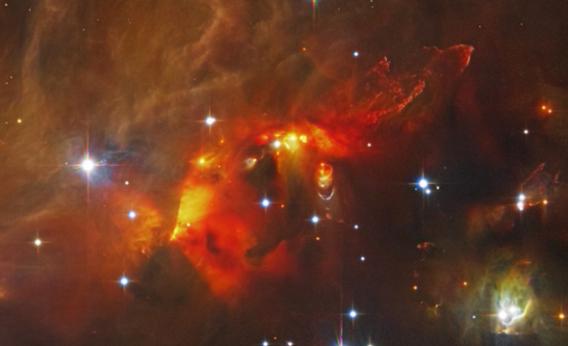Create a free profile to get unlimited access to exclusive videos, sweepstakes, and more!
Orion’s Other Nebula

The constellation of Orion is named after a great hunter, but if we wanted to be scientifically accurate, it should be named after a nursery instead.
After all, thousands of stars are being born in the direction.
The Great Nebula of Orion, M42, is a classic star-forming gas cloud, visible to the naked eye as the middle star in Orion’s “dagger.” And while M42 gets all the press, right next to it is a smaller but no less dramatic nebula, M43. Stars are forming there, too, and when you mix young, massive, hot stars and dense clouds of gas and dust, what you get is beauty.
Voilà!
Holy wow! That picture was taken by Yuri Beletsky and Igor Chilingarian. I’ve featured Beletsky’s works here on the blog before, but this is far and away the most stunning. They used the monster 6.5 meter Magellan telescope in Chile coupled with a fantastically sensitive camera called the MMIRS, which can see into the near-infrared part of the spectrum.
The colors you see here are all different wavelengths of infrared light; blue is actually light at 1 micron (just outside what the human eye can see), green at 1.6, and red at 2.2. At these colors, interstellar dust that blocks visible light is more translucent. Most images I’ve seen of M43 show it as a solid glow of light, but at these infrared colors it looks far more like you’re looking down into a cave.
That’s not entirely inaccurate! This whole region of the sky is dominated by a cold, dense, opaque cloud of molecular hydrogen and dust, completely opaque to visible light. Stars are forming inside it, and some are massive and very near the edge of the cloud on the side toward the Earth. When these hot and luminous stars switch on, they start to eat away at the cloud, carving a cavity inside it. Since they’re near the edge, this cavity can grow until it blows out the side. That’s what we see when we look at the Great Nebula, and we see it here, too.
The bright star in the image is the culprit, and you can see how the cavity is filled with more tenuous gas. Towering fingers of gas and dust point right at it; those are like sandbars in a river, dense regions resisting erosion. Stars will probably be born inside those, too, just like in the famous Pillars of Creation.
It’s interesting to compare this Magellan image with one taken by Hubble back in 2004-05:
You can see more stars in the newer Magellan image! In general, that’s true when you look at nebulae in the infrared; the dust doesn’t block the light as well. But it also depends strongly on exposure time, so I wouldn’t jump to any conclusions here. But it’s interesting to look at relative brightnesses of stars; in visible light some stars are brighter than others, but in the IR they switch! That’s because, very roughly speaking, a blue star will look brighter in visible light, and a red one will look brighter in infrared.
An obvious lesson here is that the Universe looks very different, and you learn different things, when you view it in different ways. Branch out! Embrace diversity! You’ll expose even more beauty when you do.


























